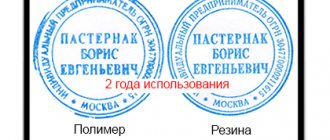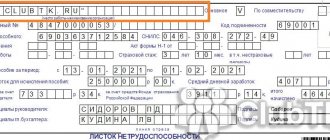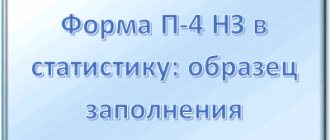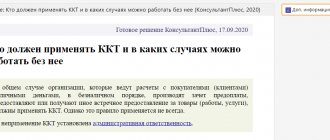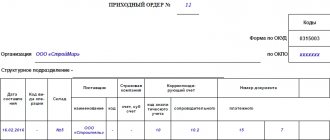One of the most important forms of annual reporting continues to be the “Cash Flow Statement” (CFDS), commonly referred to as the “fourth form”. Its presence in the financial reporting block for the year is mandatory for companies operating on OSNO and not being small businesses.
The ODDS summarizes information about all cash receipts and expenses of the company, generating a total that gives a complete picture of its cash supply, which is very important for users of all categories, and, first of all, directly for the company, since the lack of clarity in the issue of the amount of cash (DS) negatively affects the determination of the economic strategy of the enterprise and the development of further financial prospects.
Accounting Form 4: document version updated
Reporting form No. 4 was approved by Order of the Ministry of Finance No. 66n dated July 2, 2010 and is periodically transformed by legislators. Thus, by order of the Ministry of Finance of the Russian Federation No. 61n dated April 19, 2019, the ODDS was again subject to changes. They all relate to the header part of the document:
- The word “according to OKVED” is replaced with “according to OKVED2”;
- Units in “millions” are excluded. rub." and, accordingly, code 385, you have to fill out the ODDS only in thousand rubles;
- OKUD document code 0710004 has been changed to 0710005.
The tabular part of Form 4 of the financial statements in 2021 remained unchanged. The legislator obliges the use of the updated version for reporting for 2021, but it is not forbidden to form the ODDS according to the newly approved version for 2021. The balance sheet, financial results report and other forms (3, 4, 6) of financial statements must be submitted to the Federal Tax Service no later than 03/31/2020. Let us remind you that it is no longer necessary to submit accounting reports to Rosstat - from 01/01/2020, the maintenance of the state accounting information resource is entrusted to the tax authorities.
When filling out the ODDS, you should take into account the provisions of PBU 23/2011.
Form 4: form and sample filling
Form 4, filled out when obtaining access to state secrets, is called the “Questionnaire”. The questionnaire form is attached to the Instructions, approved. Government Decree No. 63 dated 02/06/2010.
Form 4 in Word can be found here.
As we noted above, the questionnaire is filled out by the person himself by hand. A photograph measuring 4x6 cm is attached to the form.
The questionnaire must be filled out no earlier than a month before it is sent to the security authority (paragraph “b”, paragraph 33 of the Instructions, approved by Government Decree No. 63 of 02/06/2010). The form 4 questionnaire is signed by an employee of the personnel department and certified by the seal of the organization or personnel department (if there is a seal) (clause 30 of the Instructions, approved by Government Decree No. 63 of 02/06/2010).
An example of filling out the form 4 form is given here.
Form 4 financial statements: structure and content
ODDS consists of 3 sections reflecting monetary transactions in the main areas of the company’s activities - current, financial, investment.
To avoid duplication of data and an unreliable increase in turnover, financial movements occurring within the enterprise (for example, currency exchange transactions, transfers between accounts) are not included in the report.
In the ODDS, all amounts are recorded regardless of the currency of payment or receipt - they are converted into Russian rubles at the current exchange rate.
The indicators of the reporting year are indicated in comparison with the data of the previous year, which clearly reflects the movement of flows in absolute values for a particular item. Amounts that reduce revenues and expenses are placed in parentheses.
The structure of all three sections of the report is identical - the first lines are allocated to the data on receipts from the relevant areas of activity, then the amounts of expenses incurred are entered and, in conclusion, the balance of funds for the section is displayed.
Cash Flow Statement: Example
As an example, consider Finist LLC, which is engaged in the wholesale trade of cars.
Here are the main indicators that served as data sources for filling out the lines of the DDS report for 2021:
| Index | Amount, thousand rubles | Line, amount thousand rubles. | Reflected amount, thousand rubles. |
| Current Operations | |||
| Revenue from the sale of cars, incl. VAT 20% | 150 000 | 4111 | 125 000 |
| Receiving funds from renting out property, incl. VAT 20% | 600 | 4112 | 500 |
| Payment to suppliers, incl. VAT 20% | 90 000 | 4121 | 75 000 |
| VAT (shown collapsed) | Outgoing: (150,000 + 600) x 20 / 120 = 25,100; Incoming: 90,000 x 20 / 120 = 15,000 | 4119 | 10 100, because outgoing VAT is greater than incoming VAT: 25,100 – 15,000 = 10,100 |
| Salary | 18 200 | 4122 | 18 200 |
| Income tax | 6 800 | 4124 | 6 800 |
| Other taxes (property tax) | 250 | 4125 (added by Finist LLC independently) | 250 |
| Receipt total | X | 4110 | 135 600 (125 000 + 500 + 10 100) |
| Payment summary | X | 4120 | 100 250 (75 000 + 18 200 + 6 800 + 250) |
| Balance by block of transactions | X | 4100 | 35 350 (135 600 – 100 250) |
| Investment operations | |||
| The loan issued in 2021 was returned to the company | 5 000 | 4213 | 5 000 |
| Dividends received from participation in other organizations | 1 200 | 4214 | 1 200 |
| A new building was purchased, payment includes VAT 20% | 12 000 | 4221 | 10 000 |
| Shares of a third-party organization were purchased | 2 000 | 4222 | 2 000 |
| VAT on the purchased building is reflected | 2 000 | 4229 | 2 000 |
| Receipt total | X | 4210 | 6 200 (5 000 + 1 200) |
| Payment summary | X | 4220 | 14 000 (12 000 + 2 000) |
| Balance by block of transactions | X | 4200 | (7 800) (6 200 – 14 000) |
| Financial operations | |||
| A contribution to the authorized capital of a new participant was received | 200 | 4312 | 200 |
| Dividends paid to founders | 13 000 | 4322 | 13 000 |
| Receipt total | X | 4310 | 200 |
| Payment summary | X | 4320 | 13 000 |
| Balance by block of transactions | X | 4300 | (12 800) (200 – 13 000) |
In the example under consideration of filling out a cash flow statement for 2021, Finist LLC looks like a completely successful enterprise: a positive result from current activities allows the company to purchase a new building and pay off the owners, i.e. cover the negative balance on investment and financial transactions.
The DDS report ends with the lines:
- 4400 – total balance for the year: 35,350 – 7,800 – 12,800 = 14,750;
- 4450 – balance of cash and cash equivalents at the beginning of the year: 9,870;
- 4500 – balance of cash and cash equivalents at the end of the year: 9,870 + 14,750 = 24,620.
As of December 31, 2020, at the cash desk and in the accounts of Finist LLC - 24,620 thousand rubles.
Filling out Form 4 of financial statements
The “header”, like the information part of any report, contains basic information:
- date and period of compilation (year),
- full name of the enterprise indicating the legal status and form of ownership;
- OKPO, OKVED codes;
- TIN;
- units of change according to OKEI.
Section 1 accumulates information on the amounts and balances at the end of the year of cash flows from current activities. When filling it out, in line 4110 indicate the total amount of receipts from current operations, then decipher it in lines 4111 to 4119, which correspond to different types of receipts indicated in the form:
- 4111 – sales revenue;
- 4112 – rent;
- 4113 – movement of financial investments;
- 4119 – other, for example, refund of tax overpayments;
Line 4120 records the total amount of payments incurred in the course of current activities. The breakdown of expenses is given in lines 4121 to 4129:
- 4121 – payment of invoices for goods and materials, raw materials, supplier services;
- 4122 – staff salaries;
- 4123 - interest paid;
- 4124 – payment of income tax;
- 4129 – other payments, for example, issuance of accountable amounts, payment of sanctions provided for in contracts.
In line 4100, the final line for section 1, the balance of funds is calculated as the difference between the amounts of lines 4110 and 4120.
In section 2, cash flows from investment processes are recorded. It is structured in the same way as the 1st - income from investments made is reflected in line 4210 and deciphered in lines 4211 to 4219.
The expense part of the 2nd section is formed from the total amount of expenses from investment activities in line 4220 and consists of the amounts of lines from 4221 to 4229.
The balance of funds in the 2nd section is displayed in line 4200, equal to the difference in the amounts in lines 4210 and 4220.
The 3rd section is structured according to the same principle, which combines information about financial activities leading to a change in the size or structure of equity capital. In line 4310 - the total amount of receipts from financial transactions, formed by the amounts of lines from 4311 to 4319.
Line 4320 records the amount of payments made as part of financial activities. Their total value is formed by the sums of lines from 4321 to 4329.
Next, the balance of financial transactions for the reporting year is calculated. Fund balances in all three sections are combined into a total balance, taking into account incoming cash balances at the beginning of the year.
If the company carried out foreign exchange transactions, then the ODDS calculates the exchange rate difference between the currencies of other countries and the Russian ruble.
Form 4 financial statements for 2021: example
Here is a sample of filling out the ODDS based on the submitted source data:
| Indicators in thousand rubles. | Line | For 2019 | For 2018 |
| Balance of DS at the beginning of the year | 4450 | 3659 | 2640 |
| Income: | |||
| — sales revenue (excluding VAT) | 4111 | 12450 | 11200 |
| — funds received from the sale of the OS | 4211 | 600 | 100 |
| - the previously issued loan was returned | 4213 | 1000 | 0 |
| — received a bank loan | 4311 | 5000 | 3219 |
| — interest received under the loan agreement | 4219 | 420 | 650 |
| Payments: | |||
| - suppliers | 4121 | 7950 | 6800 |
| - salaries paid to staff | 4122 | 1800 | 1450 |
| — insurance deductions are listed | 4122 | 540 | 440 |
| — personal income tax is listed | 4122 | 260 | 190 |
| - interest paid on the loan | 4123 | 480 | 520 |
| - loan repaid | 4323 | 2000 | 0 |
| - income tax paid | 4124 | 2800 | 2650 |
| — VAT transferred | 4129 | 1560 | 1100 |
| — a loan was issued to a third party company | 4223 | 2000 | 1000 |
| Balance of DS at the end of the year | 4500 | 3739 | 3659 |
Form 4 of the financial statements in the updated version, generated on the basis of the data presented, will look like this:
Contents of the civil service application form
Let us dwell in more detail on the information that must be provided when filling out such a questionnaire. First of all, the last name, first name and patronymic of the person filling out the form are indicated. If the last name, first name or patronymic has changed, this needs to be explained. Next, the date of birth, citizenship, education, including postgraduate education, and knowledge of foreign languages are reported. It is imperative to inform about the presence of any title, rank, category related to the civil service, to inform about access to state secrets and a criminal record.
Don't know your rights? Subscribe to the People's Adviser newsletter. Free, minute to read, once a week.
As already mentioned, information about work activity must be described in detail. It is also required to provide detailed information about relatives - indicating the degree of relationship, names, dates and places of birth, places of work and addresses; report whether any of them resides abroad temporarily or permanently.
The 3rd block of questions is intended to clarify:
- stay abroad (countries and dates);
- presence of military duty and military rank;
- address of residence (registration and actual residence, if these addresses are different);
- passport data (general civil and foreign passports);
- SNILS and INN.
In addition, there is an opportunity (and space in the questionnaire) to provide additional information about yourself if the citizen wishes to do so. The last point of the application form is the applicant’s agreement that providing false information in the application form may result in withdrawal from the competition and refusal to hire.
Who reports on it?
The report is mandatory for legal entities (except for small and medium enterprises) engaged in the industries listed in Rosstat Order No. 825 dated December 30, 2019. The type of economic activity is determined in accordance with the OKVED code. In particular, those who submit Form 4-Innovation include organizations operating in the following industries:
- development of computer programs;
- provision of electricity, gas and steam;
- Agriculture;
- mining;
- information Technology;
- accounting and legal services.
The obligation to submit a report arises regardless of the taxation system applied. Thus, enterprises operating under the simplified tax system are among those who make a 4-innovation report if their type of activity is indicated in the list given in order No. 825.
How to fill out form No. P-4
To fill out report P-4, use the Instructions.
Among the mandatory company details in the title part of the form
you need to specify:
- full name (short in parentheses);
- address (actual);
- OKPO code.
The report must be signed by the head of the organization or the responsible employee. The form provides an indication of his position, telephone number, e-mail.
Form P-4 is intended to reflect information about the company:
- average number of employees,
- number of man-hours worked,
- accrued salary fund,
- amounts of social payments.
Information on the average number of employees
for the reporting period are entered for the organization as a whole (line 01), and then listed for specific types of economic activity. The indicator of line 01 must be equal to the sum of the data in lines 02-11. Columns 2-4 reflect the number of payroll employees working under GPC contracts, external part-time workers - their total number is indicated in column 1. The average number of employees can be entered with one decimal place after the decimal point (clause 77 of Instructions No. 711).
Data on the number of man-hours worked
are entered into P-4 once a quarter. The indicator reflects how many hours were actually worked by staff from the beginning of the year until the end of the reporting period. The time spent working overtime, on weekends and holidays, as well as business trips is also taken into account (clause 82 of Directive No. 711). The period of vacation, sick leave, downtime, off-the-job training, etc. is not taken into account. It is necessary to separately calculate the hours worked by payroll employees (column 5) and external part-time workers (column 6), and enter this data broken down by type of economic activity.
Information about accrued wages
reflected in columns 7-10 of the form. The wage fund includes (clauses 84.1 - 84.4 of the Instructions):
- accrued amounts of wages for hours worked and unworked;
- compensation payments for regime and working conditions;
- surcharges and allowances;
- bonuses, incentive payments;
- systematic payment for food and accommodation.
Separately, you need to indicate the salaries accrued to different groups of employees: from the payroll, part-time workers and those working under civil contracts. You can check the correctness of the entered data using the formulas given in section. 2.4.2 Instructions No. 711.
Information about social payments
are entered into form P-4 once a quarter for the period from the beginning of the year. Social payments include severance pay upon dismissal, payment of vouchers to employees, financial assistance and other charges related to social benefits (clause 88 of Instructions No. 711). Data on sick leave, maternity benefits, child care benefits, business travel expenses, free work clothing, etc. are not taken into account. (clause 89 of Instructions No. 711). If no social payments were made during the reporting period, the indicators are not entered into the form.
For companies created as a result of reorganization, information for the period from the beginning of the year is provided by the sum of months from the moment of state registration of the new organization.

